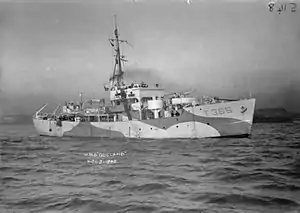HMT Gulland
04°02′50″S 39°43′57″E HMT Gulland was one of a number of Isles-class trawlers built for the Royal Navy during the Second World War for a variety of tasks, including anti-submarine patrol. She was launched placed on the disposal list after the war and sold to Belgian owners in March 1946. The following year the ship changed hands and was renamed Henken and two years later sold to Arab Navigation & Transport Co. in Aden and renamed Arab Trader.
 HMT Gulland in November 1943 | |
| History | |
|---|---|
| Builder | Cook, Welton & Gemmell, Beverley, Yorkshire, England |
| Laid down | 30 April 1943 |
| Launched | 5 August 1943 |
| Commissioned | 30 October 1943 |
| Fate | Sold for mercantile use 1946; wrecked 13 April 1951 |
| General characteristics | |
| Class and type | Isles-class trawler |
| Displacement | 545 tons |
| Length | 164 ft (50 m) |
| Beam | 27 ft 8 in (8.43 m) |
| Draught | 11 ft 1 in (3.38 m) |
| Propulsion | Single triple expansion reciprocating engine. 850 ihp (630 kW) |
| Speed | 12 knots (22 km/h; 14 mph) |
| Complement | 40 |
| Armament |
|
On 13 April 1951 the ship grounded three miles north of Mombasa, Kenya, while on a voyage from Aden to Mauritius with a cargo of lentils. Within a day or two the heavy seas flooded the engine and boiler room, and the wreck settled on the reef with the main deck awash at high water. With a cargo that was now worthless and no one in Mombasa capable of salvaging the ship, she was abandoned as a total loss. The wreck broke up in the surf and at a later date the remains were demolished with explosives. What was left of the wreck was rediscovered in the 1970s on an extremely low tide in front of the Reef Hotel consisting of a pile of steel plate and machinery on the edge of the reef at its current location.